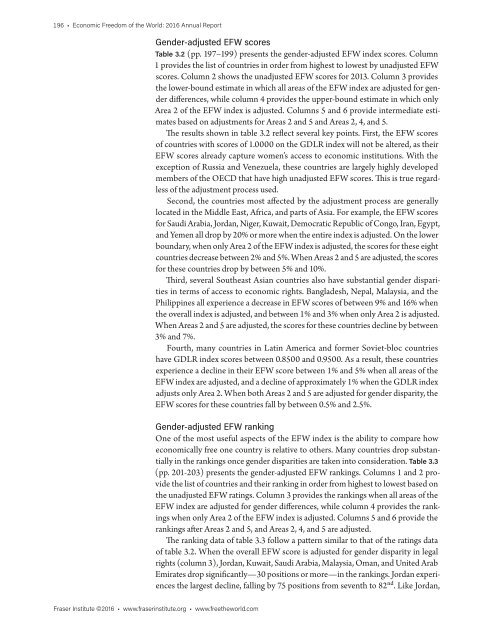Economic Freedom of the World
economic-freedom-of-the-world-2016
economic-freedom-of-the-world-2016
Create successful ePaper yourself
Turn your PDF publications into a flip-book with our unique Google optimized e-Paper software.
196 • <strong>Economic</strong> <strong>Freedom</strong> <strong>of</strong> <strong>the</strong> <strong>World</strong>: 2016 Annual Report<br />
Gender-adjusted EFW scores<br />
Table 3.2 (pp. 197–199) presents <strong>the</strong> gender-adjusted EFW index scores. Column<br />
1 provides <strong>the</strong> list <strong>of</strong> countries in order from highest to lowest by unadjusted EFW<br />
scores. Column 2 shows <strong>the</strong> unadjusted EFW scores for 2013. Column 3 provides<br />
<strong>the</strong> lower-bound estimate in which all areas <strong>of</strong> <strong>the</strong> EFW index are adjusted for gender<br />
differences, while column 4 provides <strong>the</strong> upper-bound estimate in which only<br />
Area 2 <strong>of</strong> <strong>the</strong> EFW index is adjusted. Columns 5 and 6 provide intermediate estimates<br />
based on adjustments for Areas 2 and 5 and Areas 2, 4, and 5.<br />
The results shown in table 3.2 reflect several key points. First, <strong>the</strong> EFW scores<br />
<strong>of</strong> countries with scores <strong>of</strong> 1.0000 on <strong>the</strong> GDLR index will not be altered, as <strong>the</strong>ir<br />
EFW scores already capture women’s access to economic institutions. With <strong>the</strong><br />
exception <strong>of</strong> Russia and Venezuela, <strong>the</strong>se countries are largely highly developed<br />
members <strong>of</strong> <strong>the</strong> OECD that have high unadjusted EFW scores. This is true regardless<br />
<strong>of</strong> <strong>the</strong> adjustment process used.<br />
Second, <strong>the</strong> countries most affected by <strong>the</strong> adjustment process are generally<br />
located in <strong>the</strong> Middle East, Africa, and parts <strong>of</strong> Asia. For example, <strong>the</strong> EFW scores<br />
for Saudi Arabia, Jordan, Niger, Kuwait, Democratic Republic <strong>of</strong> Congo, Iran, Egypt,<br />
and Yemen all drop by 20% or more when <strong>the</strong> entire index is adjusted. On <strong>the</strong> lower<br />
boundary, when only Area 2 <strong>of</strong> <strong>the</strong> EFW index is adjusted, <strong>the</strong> scores for <strong>the</strong>se eight<br />
countries decrease between 2% and 5%. When Areas 2 and 5 are adjusted, <strong>the</strong> scores<br />
for <strong>the</strong>se countries drop by between 5% and 10%.<br />
Third, several Sou<strong>the</strong>ast Asian countries also have substantial gender disparities<br />
in terms <strong>of</strong> access to economic rights. Bangladesh, Nepal, Malaysia, and <strong>the</strong><br />
Philippines all experience a decrease in EFW scores <strong>of</strong> between 9% and 16% when<br />
<strong>the</strong> overall index is adjusted, and between 1% and 3% when only Area 2 is adjusted.<br />
When Areas 2 and 5 are adjusted, <strong>the</strong> scores for <strong>the</strong>se countries decline by between<br />
3% and 7%.<br />
Fourth, many countries in Latin America and former Soviet-bloc countries<br />
have GDLR index scores between 0.8500 and 0.9500. As a result, <strong>the</strong>se countries<br />
experience a decline in <strong>the</strong>ir EFW score between 1% and 5% when all areas <strong>of</strong> <strong>the</strong><br />
EFW index are adjusted, and a decline <strong>of</strong> approximately 1% when <strong>the</strong> GDLR index<br />
adjusts only Area 2. When both Areas 2 and 5 are adjusted for gender disparity, <strong>the</strong><br />
EFW scores for <strong>the</strong>se countries fall by between 0.5% and 2.5%.<br />
Gender-adjusted EFW ranking<br />
One <strong>of</strong> <strong>the</strong> most useful aspects <strong>of</strong> <strong>the</strong> EFW index is <strong>the</strong> ability to compare how<br />
economically free one country is relative to o<strong>the</strong>rs. Many countries drop substantially<br />
in <strong>the</strong> rankings once gender disparities are taken into consideration. Table 3.3<br />
(pp. 201-203) presents <strong>the</strong> gender-adjusted EFW rankings. Columns 1 and 2 provide<br />
<strong>the</strong> list <strong>of</strong> countries and <strong>the</strong>ir ranking in order from highest to lowest based on<br />
<strong>the</strong> unadjusted EFW ratings. Column 3 provides <strong>the</strong> rankings when all areas <strong>of</strong> <strong>the</strong><br />
EFW index are adjusted for gender differences, while column 4 provides <strong>the</strong> rankings<br />
when only Area 2 <strong>of</strong> <strong>the</strong> EFW index is adjusted. Columns 5 and 6 provide <strong>the</strong><br />
rankings after Areas 2 and 5, and Areas 2, 4, and 5 are adjusted.<br />
The ranking data <strong>of</strong> table 3.3 follow a pattern similar to that <strong>of</strong> <strong>the</strong> ratings data<br />
<strong>of</strong> table 3.2. When <strong>the</strong> overall EFW score is adjusted for gender disparity in legal<br />
rights (column 3), Jordan, Kuwait, Saudi Arabia, Malaysia, Oman, and United Arab<br />
Emirates drop significantly—30 positions or more—in <strong>the</strong> rankings. Jordan experiences<br />
<strong>the</strong> largest decline, falling by 75 positions from seventh to 82 nd . Like Jordan,<br />
Fraser Institute ©2016 • www.fraserinstitute.org • www.free<strong>the</strong>world.com


